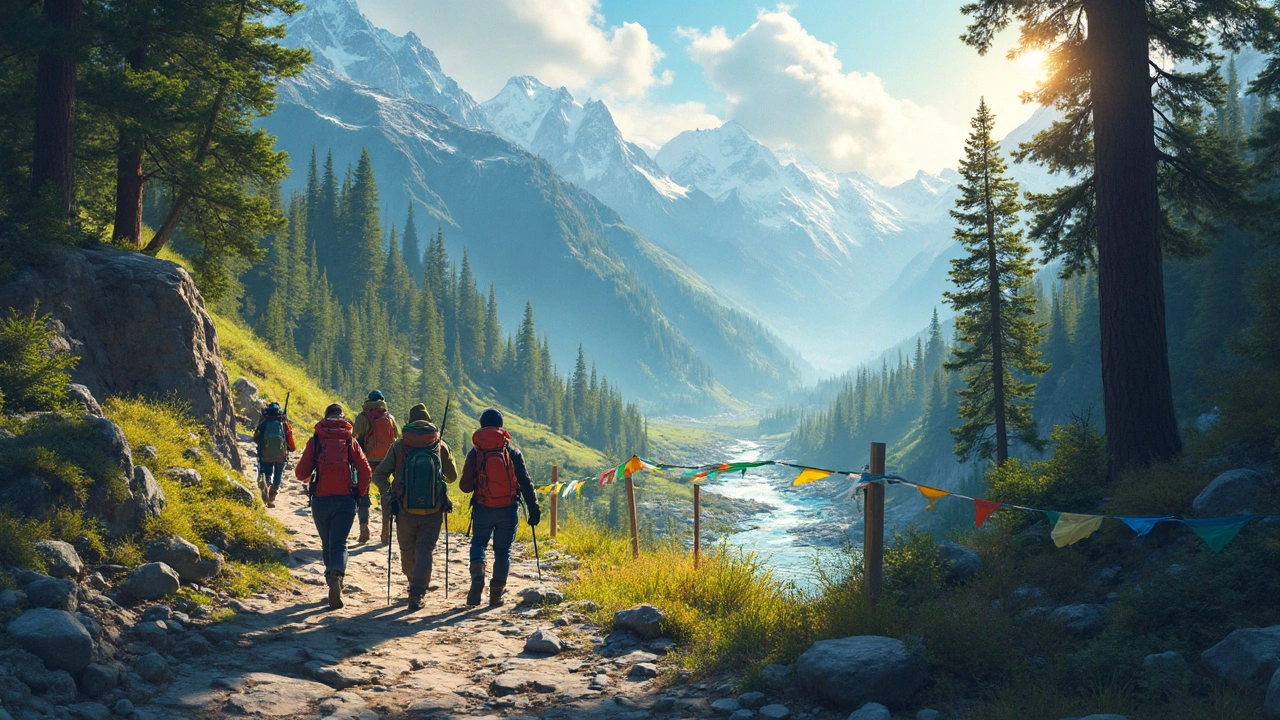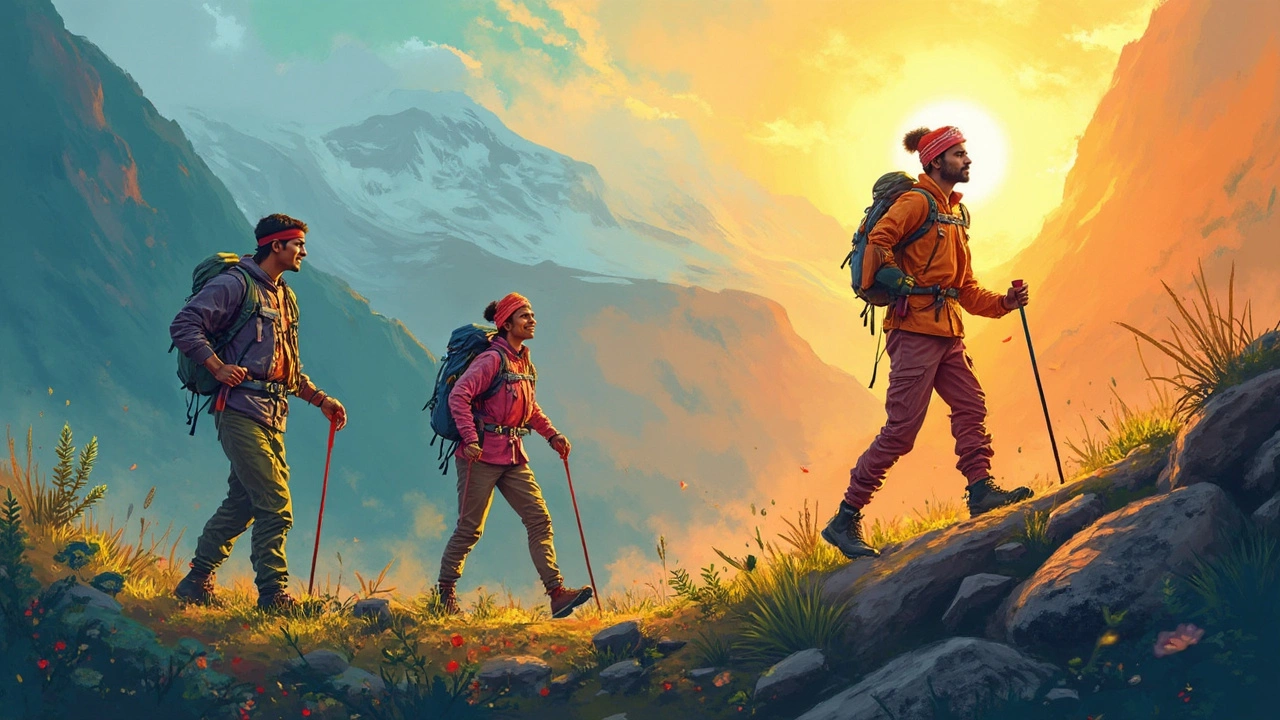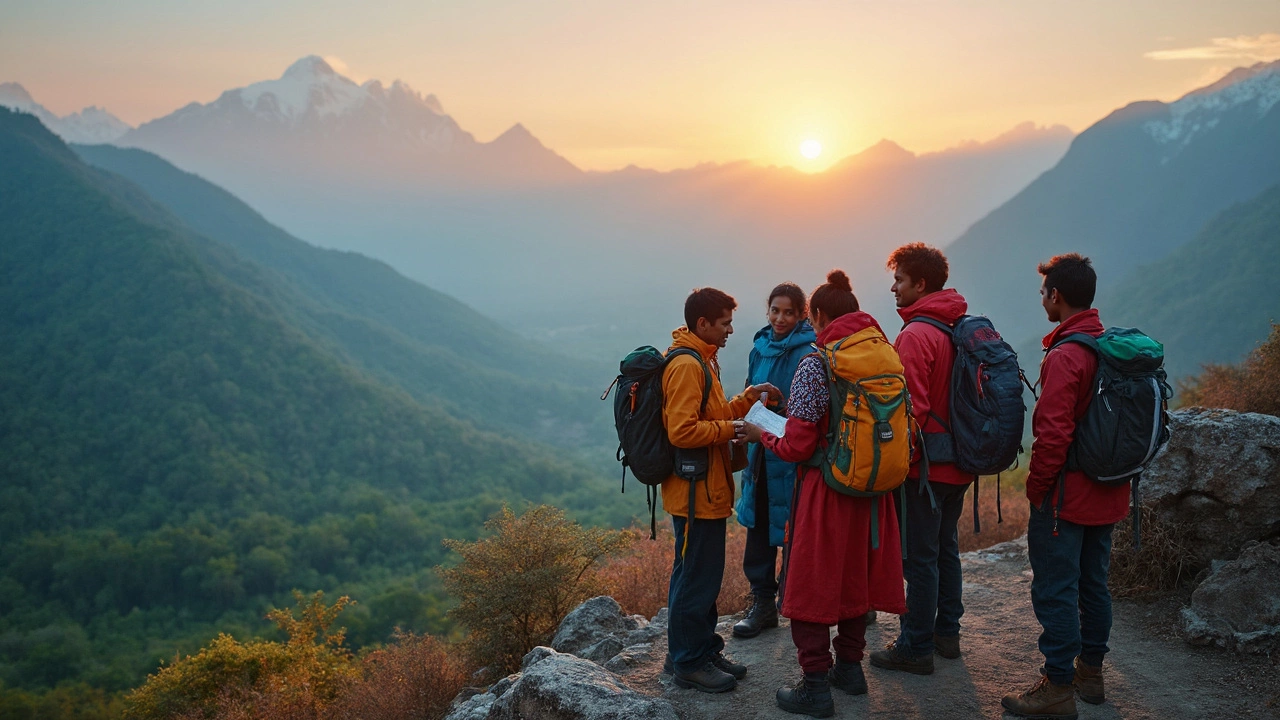Trekking in India: What Your Body Experiences Along the Way

Trekking in India isn’t just about the mesmerizing landscapes; it's also about what happens to you along the trek. Imagine walking through dense forests, steep hills, and chilly streams while your heart and lungs do an intense workout. It’s like giving your body a natural tune-up.
With all that fresh air and physical exertion, your body starts building more red blood cells to adapt. You’ll probably notice your stamina improving after a few treks, and that’s just your body getting used to moving better in harmony with nature.
This isn’t just a physical journey. Your mind reaps the benefits too. While you’re trekking, endorphins—the happy hormones—kick in, leaving you feeling more content and clear-headed. It’s like a natural mood booster, getting you through those grueling miles with a smile.
- Physical Impacts of Trekking
- Mental Health Boosts
- Preparing for the Trails
- Popular Trekking Locations in India
- Essential Gear and Packing Tips
- Post-Trek Recovery and Care
Physical Impacts of Trekking
When you decide to go trekking, especially through the rugged terrains of India, your body is in for a workout. First off, your muscles, particularly in your legs and core, start to strengthen. Think of all those uphill climbs and rocky paths—it's like a natural gym session! As your muscles adapt, you get stronger and more resilient over time.
Your heart and lungs also get a real boost. Trekking helps improve your cardiovascular health significantly. As you walk, your heart rate increases, improving circulation and oxygen flow. This can lead to a lower resting heart rate and better lung capacity in the long run.
You might be surprised to know that trekking even improves your bone density. The weight-bearing nature of trekking means your bones are constantly working against gravity, which can help maintain or even boost bone health—pretty important as we age!
According to Dr. Amanda Jones, a well-known sports physiologist, "Trekking at high altitudes nudges your body to produce more red blood cells, improving your oxygen efficiency and overall endurance."
Trekking in places like the Himalayas also introduces your body to different atmospheric pressures. This adaptive process can enhance your acclimatization skills, useful if you're planning to conquer higher peaks in the future.
Don't forget about calories! On longer treks, your body burns through energy faster than usual. Typically, a person burns between 430 to 540 calories per hour of trekking, depending on the trail difficulty and speed. That means you'll need to refuel with nutritious snacks to keep energy levels up.
- Carry trail mix or energy bars for quick boosts.
- Stay hydrated! Water is your best friend on the trails.
- Consider bringing electrolyte tablets to mix with water, replacing lost salts and minerals.
So, as you embark on your adventure, remember that your body is not just going through the motions. It's evolving, getting fitter, and embracing the wildness of trekking. Now you’ll navigate those stunning Indian landscapes with more ease and less struggle.
Mental Health Boosts
The benefits of trekking in India go far beyond the physical. Ever notice how you feel clearer and more energized after a longs stroll in a park? Now multiply that by tenfold as you hit those majestic trails. It's all about the endorphins and the sheer serenity the natural environment brings.
So, what's happening in your brain during a trek? Well, there's this natural cocktail of chemicals like dopamine and serotonin that your body creates. These are the same chemicals that most antidepressants aim to boost. A day's hike can work similar magic. Plus, trekking demands genuine focus and presence, keeping stress at bay.
There’s also something magical about being away from the urban hustle. Up in the mountains, you gain perspective. Problems seem smaller, stress fades, and you return with a better mindset. Studies suggest that nature immersion, like trekking, can reduce anxiety and depression levels significantly.
- Improved Mood: Those elevated tears while reaching a summit aren't just from seeing the view! They’re your brain enjoying a release of feel-good chemicals.
- Reduces Stress: Breathing in that fresh mountain air slows your cortisol (stress hormone) production.
- Mental Clarity: With fewer distractions, your mind has the chance to unwind.
- Boosts Creativity: Being in nature has been shown to help spark fresh ideas and solutions to problems you may have been dwelling on.
If you're a beginner, don't worry about diving into the deepest trails. Start with shorter treks and work your way up. Your mental health benefits increase with the frequency of your treks, so make it a regular habit.
A 2015 study from Stanford reports reduced brain activity in areas associated with repetitive negative thoughts when participants spent time in nature, including trekking environments. Isn't that a good excuse to plan your next adventure?
Preparing for the Trails
Alright, so you’ve decided to tackle trekking in India. Exciting choice! But before you hit the trails, there are some important things to get right. Preparation is key, and trust me, a little planning goes a long way in making your trek a memorable adventure rather than a struggle.
First up, consider your fitness level. Trekking isn’t just about walking; it’s about endurance. Start with some cardiovascular exercises like jogging, swimming, or cycling a few weeks prior. Building core strength and flexibility through yoga or pilates can also be super helpful. The goal? Walk comfortably with a backpack for a couple of hours.
Speaking of backpacks, let’s chat gear. Packing smartly is essential. Keep your load light but ensure you have essentials:
- Trekking shoes: Invest in waterproof, ankle-supporting boots. Your feet are going to be doing all the hard work!
- Water bottle and filtration system: Staying hydrated is crucial, and having a filtration system can save you.
- Weather-appropriate clothing: Layering is your friend, since weather can change faster than you’d expect up there.
- First-aid kit: Blisters, cuts, and altitude sickness can put a damper on things. Be prepared.
- Navigation tools: Whether it’s maps or GPS, knowing where you’re headed reduces stress.
Next, do a little research on where you're going. Some areas in India known for trekking, like the Himalayas, require permits. Check the regulations and ensure you have everything in place beforehand. Knowing local weather patterns helps decide the best time to visit, usually around pre-monsoon (March-May) or post-monsoon (September-November).
Here's a pro tip: acclimate to higher altitudes if your trek involves climbing. Spend a day or two at a high-altitude base before going higher. Trust me, your lungs will thank you.
And finally, consider eco-friendly practices. Stick to marked trails and carry out what you carry in. The beauty of trekking isn’t just the view but making sure it's there for others too.
So, ready to start trekking in India? With the right prep, those trails are going to lead to some amazing places and experiences.

Popular Trekking Locations in India
India is a goldmine for those who love trekking. With the vast landscape ranging from the mighty Himalayas to the lush Western Ghats, there's something for every adventurer.
First up is the Chadar Trek in Ladakh. It's a unique experience where you walk on a frozen river, offering views that are nothing short of spectacular. The trek usually takes place during the harsh winter months when the Zanskar River turns into a sheet of ice. It's not just challenging but incredibly rewarding, bringing you face-to-face with some of the most remote parts of India.
Then there's the Valley of Flowers Trek in Uttarakhand, ideal for those who love nature's colors. This trek is set in a vibrant national park known for its meadows of endemic alpine flowers and diverse fauna. It's like walking through a painting, with every step offering a new shade of beauty. The best time to visit is between July and September when the flowers are in full bloom.
For those looking to challenge themselves, the Roopkund Trek is a must. Known for its mysterious skeletal lake, Roopkund is an exciting trail that takes you through dense forests, scenic campsites, and glacier views, ending at the enigmatic lake filled with ancient bones.'
If you’re in the south, the Kudremukh Trek in Karnataka offers breathtaking views without the chill of the north. It’s famous for its rolling hills and abundant wildlife, offering a different kind of trekking experience, one that's more about enjoying the serenity and less about conquering the elements.
Here's a quick snapshot of some treks with their best seasons:
| Trek | Best Season |
|---|---|
| Chadar Trek | January - February |
| Valley of Flowers Trek | July - September |
| Roopkund Trek | May - June |
| Kudremukh Trek | September - February |
No matter which trek you choose, each offers its own set of thrills and sights that make trekking in India an unforgettable adventure. Just make sure to prepare adequately and respect the natural trails along the way.
Essential Gear and Packing Tips
Heading out on a trek can feel overwhelming with all the gear talk, but let’s keep it simple. You don’t need to break the bank, but having the right trekking essentials is a game-changer.
First off, a good pair of boots is your best mate. Look for something that offers ankle support and has a solid grip, especially if you’re trekking in India where the terrain can be pretty diverse. Wet socks? No thanks! A few pairs of moisture-wicking socks will keep your feet dry and blister-free.
Layers are crucial. The weather can change faster than you can say “Himalayas.” Start with a sweat-wicking base layer, add a warm middle layer, and top it off with a waterproof jacket for the unexpected rains.
Next up, your backpack—it’s got to be spacious enough for all your stuff but not so big that it becomes a pain to carry. Look for one with a decent capacity, around 30-40 liters is usually a sweet spot for a few days of trekking.
Pro tip: Always carry a small first-aid kit. You might not need it, but better safe than sorry, right?
- Sunscreen, sunglasses, and a hat – don’t forget sun protection! At altitudes, you’ll burn faster.
- A refillable water bottle or hydration pack. Staying hydrated is key wherever you’re trekking.
- Snacks, like energy bars or dry fruits—easy to carry and a lifesaver for a quick energy boost.
- Compact camera or smartphone for snaps. Trust me, you’ll want to capture the stunning views.
- If you’re camping, a lightweight tent and sleeping bag that are easy to pack are a must.
Now, how about a few numbers to chew on? Did you know that the average backpack shouldn’t weigh more than 20% of your body weight? This keeps you from overloading and straining.
With these tips, you’re all set to enjoy those stunning landscapes in style and comfort. Keep the gear light yet functional, and relish every step of your trekking adventure in India.
Post-Trek Recovery and Care
Congratulations! You've completed a trek in India, whether it was through the Himalayas or the Western Ghats. But what happens to your body after all that effort and how should you take care of it?
Your muscles might be screaming, and that’s because they’ve been stretched to their limits. To help them recover, start with a good stretch right after your trek. Gentle stretching eases tension and reduces soreness.
Next, hydrate like your life depends on it. During trekking in India, you lose a lot of fluids. Drinking water will help with muscle recovery and overall energy levels. If you have a preference for something a bit tastier, coconut water or electrolyte drinks can do wonders too!
Nourishment is key after a trek. Load up on proteins and healthy carbs. A hearty meal with foods like chicken, lentils, or beans paired with rice or potatoes gives your body the fuel to repair muscles effectively.
Listen to your body for signs of issues like persistent pain or unusual fatigue that doesn't improve in a couple of days. Such signs might need a professional check-up.
Sleep is often underestimated but it's one of the best recovery tools. Aim for a full night's sleep to let your body repair and rejuvenate naturally.
If you’ve got trek buddies or a partner like my Adelaide back in Manchester, consider a gentle massage. It not only feels amazing but also can boost circulation, speeding up healing.
Here’s a quick checklist for post-trek recovery:
- Stretch as soon as your trek is done.
- Hydrate with water or electrolyte drinks.
- Eat protein and carb-rich meals.
- Look out for unusual aches that won’t quit.
- Prioritize rest and sleep.
- Consider a massage for tired muscles.
Keep in mind, your post-trek care sets the foundation for how you'll feel in the coming days. Treat your body well, and it’ll be ready for the next adventure quicker than you'd think!
